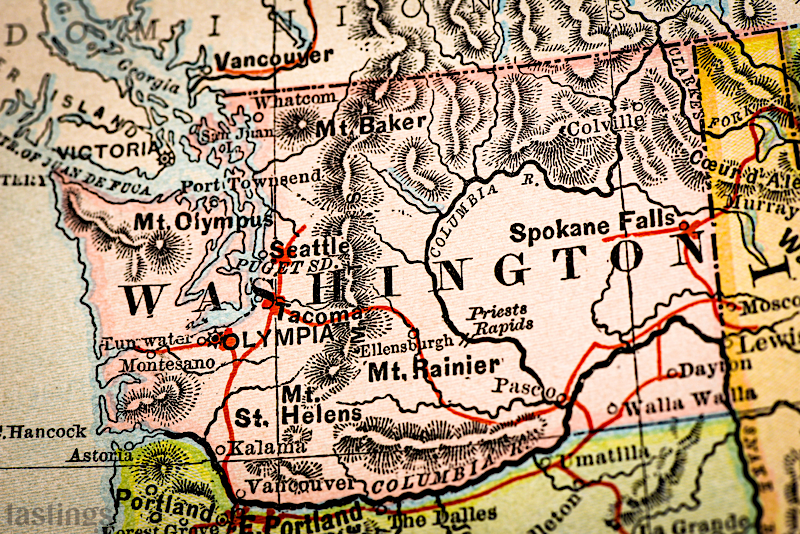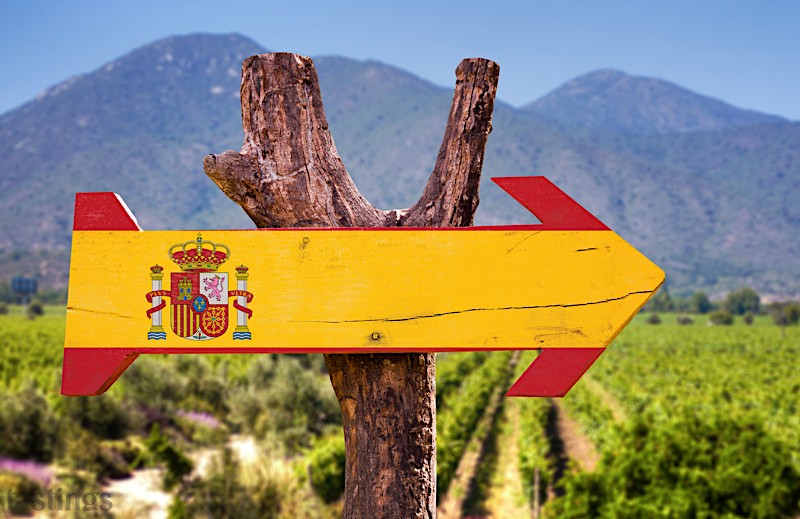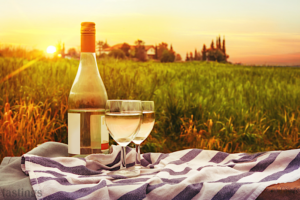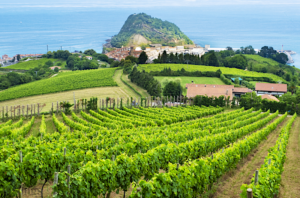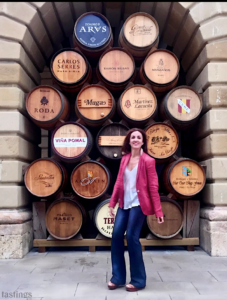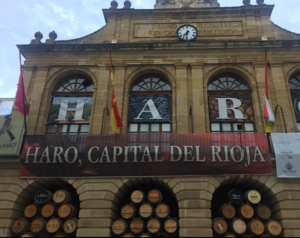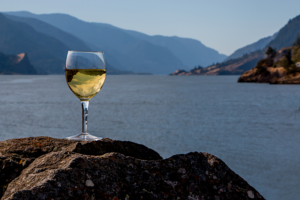
Washington State is the second largest wine producer in the United States, with a yearly volume of more than 17 million cases of wine; and much of that generated by one winery, the state’s oldest existing: Chateau Ste. Michelle. In fact, Chateau Ste. Michelle produces more wine than the entire neighboring state of Oregon. But before we dig into “the Chateau,” let’s review the industry’s history in this Pacific Northwest state.
Washington Wine History
Washington wine dates back to 1825, when the first grape vines were planted by the Hudson Bay Company at Fort Vancouver. Pioneer William B. Bridgman later introduced vinifera vines to Yakima Valley in the early 1900s and in the 1930s, Dr. Walter Clore, recognized as the father of the Washington wine industry, researched what varieties would grow well in the state. These early innovations, research, and pioneers later gave way to the significant growth of the industry in the 1960s and ‘70s.
The Yakima Valley, Columbia Valley, and Walla Walla Valley emerged as prominent wine regions, cultivating varieties like Cabernet Sauvignon, Merlot, and Riesling. The industry’s growth continued through the late 20th century, marked by the establishment of numerous wineries and a focus on producing high-quality wines that reflected the unique terroir of Washington. Today the industry is thriving with more than 1,000 wineries and 80 different varieties planted across 20 American Viticultural Areas (AVAs).
Why Washington
Although there are 60,000 acres of wine grapes across Washington, the majority are located within the Columbia Valley AVA in the eastern part of the state. Here, the Cascade Mountains block the wet weather from the Pacific Ocean and create dry, warm conditions. In other words, it’s a high desert with as much as 17-hours of sun during the growing season and very hot days followed by very cool nights. That diurnal temperature swing (sometimes as much as 50-degrees between day and night) is key for maintaining acidity in the grapes. As for the soils, throughout the Columbia Valley you’ll find a basalt foundation resulting from old lava flows, glacial slack water deposits from the Missoula floods, loess, and free draining, nutrient-poor composites making up the majority. These porous and well-draining soils are ideal for growing grapes and they provide a source of minerals to help the vines thrive.
With only one AVA west of the Cascades, the Puget Sound AVA, the majority of the regions across Washington are similar in climate to the Columbia Valley, but with varied soils, micro-climates, and elevations. It’s largely an arid to semi-arid region, geologically and geographically advantageous for growing a variety of grapes with balanced levels of acid, sugars, and structure.
The Chateau
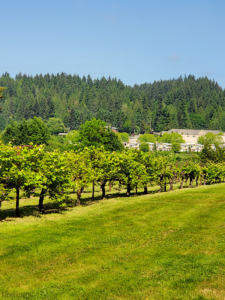
Despite being the second largest producer of wine in the US, most of Washington’s wine is sold within the state, with only the largest wineries receiving nationwide distribution. One such winery is the iconic Chateau Ste. Michelle which has largely shaped the trajectory of the Washington wine industry.
Established in 1934, Chateau Ste. Michelle is Washington’s oldest winery. Initially known for its Riesling production, the winery later diversified its portfolio, showcasing the versatility of the state’s terroir. As a leader in both production and distribution, accounting for more than 50% of the state’s share, the Chateau has helped bring Washington wines to a global audience and launched the wine tourism industry. It has also significantly contributed to the state’s overall economy, education system, and greater community through its extensive outreach and philanthropy. And it is near impossible to find someone at one of the other 1,000+ wineries or 400 vineyards across the state without a connection to, or roots at, the Chateau. It has mentored many emerging winemakers and growers, contributing to the growth and maturation of the entire industry.
Although the Chateau was purchased by a private equity firm, Sycamore Partners, in 2021, and despite its release of 40% of its vineyard contracts in 2023, it remains a significant player in the state’s wine tourism industry. Much of the state’s wine is sold in Washington tasting rooms and direct to consumer sales are paramount for most of the state’s wineries. And while Chateau Ste. Michelle wines are found internationally, its sprawling estate and summer concert series draws more than 300,000 visitors from around the world annually
Visiting the Chateau
Located in Woodinville, Washington, just a 30-minute drive from downtown Seattle, Chateau Ste. Michelle sits on 105-wooded acres. The Chateau itself is surrounded by lush gardens, vineyards, and sprawling lawns. The tasting room is open daily and while reservations are recommended, walk-in appointments are available on a first come, first serve basis. And like the wines available to sample, there is no shortage of experiences to try – from classic flights or food pairings, to blending trials and sparkling extravaganzas. You can also opt for something more private as well. Igloos are available for rental in the winter, the grounds are open for picnics year-round, and twilight hours are an option for a shared glass or bottle on Friday and Saturday evenings. And as previously mentioned, the summer concert series is also not to be missed. As for the wines, while you think you might know the range from your local market or restaurant, rest-assured you’ve only seen the tip of the iceberg. This is a Washington icon not to be missed.
Experience Woodinville
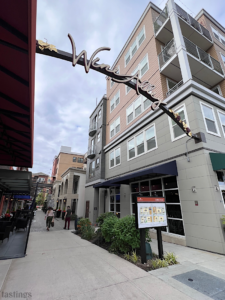
As you can likely ascertain from the over 300,000 people flocking to Woodinville each year, a few more wineries have found a home in the area. It’s part of that Chateau effect. In fact, today more than 130 wineries from nearly every AVA across the state can be found in Woodinville across four districts: Hollywood, Warehouse, Downtown, and West Valley. Within these districts there are also spots like Wine Alley and Wine Walk, and sitting just outside of Woodinville, there are a few chic “garage” winemaking hotspots: SoDo and Maltby. A few out-of-state wineries have even made their way to this wine tourism destination. In fact, the Warehouse District is the home of more boutique wineries per square foot than any other wine region in the world! And while we don’t have the space to dive into the many producers worth your time and tasting, a few wineries from Woodinville’s various districts are highlighted below.
Alluvium Cellars is a boutique winery located at The Junction in Woodinville’s Warehouse District. One of the oldest of the area districts, these small warehouses are where the wine is made and many area wineries get their start. Alluvium is one of the newest players in the Warehouse District focusing on crafting premium small batch wines. The wines are made from grapes sourced from several the top vineyards and produced in small lots. Winemaker Tyson Trautmann doesn’t shy away from innovative winemaking techniques as he seeks to leverage technology to enhance the process. The Alluvium tasting room, open Fridays to Sundays, was designed by Trautmann’s wife Brittany Trautmann, and features a modern-rustic aesthetic reflective of the wines – and you’ll taste right where its made.
Recommended wines: 2022 Apricity (Rhone-style white), 2022 Armogan (Chardonnay),
2021 Anthem (Rhone-style red), and the 2022 Alyssum (Grenache).
Damsel Cellars proves that not all Damsels are in distress. Found in Woodinville’s Hollywood District, Damsel Cellars’ winemaker, Mari Womack, began her career in 2010, working in nearby Woodinville tasting rooms and volunteering during harvest. She eventually became the assistant winemaker at Darby Winery before subsequently launching her own boutique line of wines at Damsel Cellars. Womack specializes in red wines including Syrah and Cabernet from Columbia Valley, but the white wines are equally compelling. The Hollywood winery is open seven days a week, and the second location, located in the Artisan Hills is open Saturday and Sunday.
Recommended wines: 2022 Damsel Cellars Boushey Vineyard Marsanne, 2020 Damsel Boushey Vineyard Syrah, 2020 Damsel Cellars Boushey Vineyard Cabernet Franc, and the 2021 Damsel Cellars Syrah “MEDUSA.”
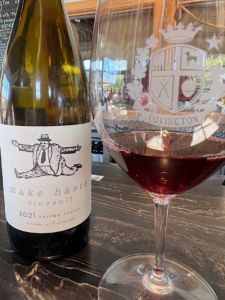
Two Vintners, is larger than the two aforementioned Woodinville producers and is found both in the Warehouse District as well as The Vault in the newest winemaking district, Maltby. And although the Two Vintners label is relatively new, its sister winery, Covington Cellars was founded by Cindy & David Lawson as the 19th winery to open in Woodinville in 2002. They’ve since grown to include Two Vintners, in partnership with winemaker Morgan Lee. Lee oversees all wine production for both wineries and was recently named “Winemaker to Watch” by Seattle Magazine, but a few sips into his line up and you won’t need anyone to tell you that. His talent speaks through the wine. Between the two wineries Lee and the Lawsons are delivering a range of varieties from Riesling, Gewürtztraminer, and Grenache Blanc to Cabernet Franc, Cinsault, Syrah, and Merlot. They play with a lot of varieties, but not only are the wines great, you can tell they have fun making them. Both locations are open Fridays through Sundays with reservations required for groups of 6 or more.
Recommended wines: 2021 OG, 2021 Make Haste Cinsault, and 2020 Some Days Are Stones Syrah.
And lastly, a long-time favorite and more established Washington winery, Barnard Griffin. With its original location in eastern Washington, the Woodinville tasting room is found along the newly opened Wine Walk Row with numerous wine tasting rooms, shops, and restaurants. Barnard Griffin was founded in 1983 by Rob Griffin and his wife Deborah Barnard. Today the family operation also includes second-generation winemaker, daughter, Megan Hughes. It is one of Washington’s most enduring and award-winning wineries with a range of well-crafted wines from select vineyards across the state.
Recommend wines: 2022 Rose of Sangiovese, 2017 Reserve Cabernet Sauvignon, and 2018 Petit Verdot – Lonesome Spring Ranch.
Washington is a major player nationwide, but while a few of the larger, icon wineries are spreading awareness globally, many of the state’s 1,000+ producers remain largely dependent on wine tourism and direct to consumer sales. And with the recent divestiture of vineyard contracts by the Chateau coinciding with a decrease in wine sales worldwide, tourism and brand awareness are even more tantamount to the region’s success. But with so many unique producers and 80 varieties growing state-wide, each showcasing the state’s versatility, there’s far more waiting to be discovered.

